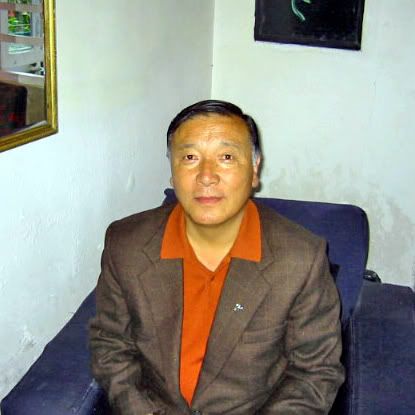Back in October 2006, I had the pleasure of enjoying Meghma Tea Garden's autumnal oolong from the Eastern Nepal. A discussion on whether the tea was hand processed / rolled ensued under that post. The sample received and tasted then was too broken for proper observation.
I have had again the pleasure of drinking this tea (recently purchased, not the same order as last October's sample).
 In Eastern Nepal, close to the border that separates it from India's Darjeeling district, Mr. Madan Tamang grows Camellia sinensis and rhododendrons. The tea estate, aptly named after his ancestral village of Meghma, produces one of the most natural and unique oolong teas in the world.
In Eastern Nepal, close to the border that separates it from India's Darjeeling district, Mr. Madan Tamang grows Camellia sinensis and rhododendrons. The tea estate, aptly named after his ancestral village of Meghma, produces one of the most natural and unique oolong teas in the world.The words “remote”, “no road”, and “purest” have been used to describe Mr. Tamang’s Meghma estate and its production methods. That is understandable, considering that the tea processing facility is located at about 7,000 feet or higher. This is a place in Nepal where electricity (by public utility) has not dared reach and where “charcoal” has to be handmade to fuel the roasting of the tea.
Tasting Note: 2006 Meghma Tea Estate, Autumn Harvest Oolong, Khalikhop Valley, Eastern Nepal

Source: The Simple Leaf Tea under the name "Honeybee" ($13.95 per 4oz)
Dry leaves: bouquet of nuts, honey, very ripe mango and high notes of yellow tropical fruits' acidity. When thrown into a warmed-up gaiwan, the leaves exude deeper and sweeter aforementioned aromas. Lovely!
Brewing parameter (gongfu): 205 – 208 F (96 – 98 C) spring water, dry leaves filling 1/3 of the gaiwan, flash rinse, then 5s, 5s, 10s, 15s, 30s, 1m.
The liquor’s medium amber color and its crystal clear clarity remind me, somehow, of eau de vie that has slumbered for many decades in oak barrels. Nutty with honey-like taste and a touch of acidity that brings the tea alive. The texture is smooth and a bit oily. Medium bodied. Finishes with an earthy, dark mushroom taste that lingers. After swallowing, the tea’s astringency is felt and it produces a mouth-drying effect. I feel thirsty again quite instantly.
The leaves are decidedly larger and more whole than last October's sample. I say "more whole" because the steeped leaves are a mix of whole and chopped leaves as well as stems.
This tea is rather easily spent, however, managing to produce 4 delicious infusions before turning watery. A lovely and complex tea overall, while it lasts.
4 stars (very good)
Were the leaves hand processed and rolled, then? According to Mr. Tamang in his interview with Nikhil of The Simple Leaf Tea:
 Yes, our tea is completely hand rolled. Our methods are actually very simple - after plucking the green leaf, it is manually hand-rolled and then spread out on a table and covered with a moist cloth for the semi-fermentation process to begin. This takes up to 4 hours.
Yes, our tea is completely hand rolled. Our methods are actually very simple - after plucking the green leaf, it is manually hand-rolled and then spread out on a table and covered with a moist cloth for the semi-fermentation process to begin. This takes up to 4 hours.
The leaves are then placed on large pans with handles and charcoal-fired for about 10 to 15 minutes, depending on atmospheric conditions.
The leaves are then placed on a table for cooling - up to 3 or 4 hours. These unsorted, dried leaves are then passed through a series of meshes of varying sizes to separate the larger leaves from the smaller ones. In the industry, we call this grading. Finally, we pack the tea into plywood chests or paper sacks and the production process is complete."
Every time I brew Mr. Tamang's oolong, it enchants me with its exquisite bouquet and taste. He has got a fan in me. His latest 2007 spring oolong will soon be available for sale, and I look forward to tasting the fresh crop.
Rajiv Lochan discussed briefly about Mr. Tamang’s biodynamic farming approach at T Ching.
Nikhil Roychowdhury of The Simple Leaf Tea conducted a one-on-one interview with the man himself. Find out who Madan Tamang is, his agricultural approach and his vision.
(Photo of Madan Tamang provided by The Simple Leaf Tea)
8 comments:
A lovely post as always!
Those leaves look gorgeous in the cup... Just by looking at them you can almost expect to find a honey-fruitiness. Yum!
tb.
Thank you, TB. I have high hopes for the 2007 vintage.
A tasting event of this oolong is under consideration and in planning at T Ching. This could be a good opportunity for those who are interested in trying it out. I'll post an announcement should this plan takes shape.
I've noticed that about Indian oolongs -- they don't last, giving up about 5 infusions in. I found that to be true of the few oolongs Mr. Lochan generously sent me. They were good while they were brewing, but turned watery and ... that was that.
I was rather surprised too, given my parameter and the generous amount of leaves I used (closer to 1/2 than 1/3).
The first 3 to 4 infusions were lovely!
Glad to have found you. Your knowledge and aesthetics make this a valuable blog. I linked to you from my blog today.
Thank you Tea Party Girl! I enjoyed your blog, too. Which part of N. CA do you live in?
Thanks, I enjoyed that. Its nice to see people take an interest in where there tea comes from.
I love Asian teas. i tasted the Honeybee it is amazing.
Great great post!
Cheers,
Blair
Post a Comment